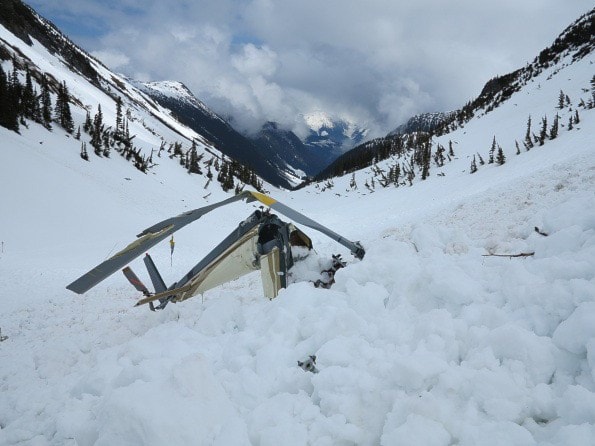A Transportation Safety Board investigation into a helicopter crash that claimed the lives of three people near Terrace last year is citing sudden loss of visibility as well as a lack of instruments and instrument training as the cause of the crash.
The Bailey Helicopters’ Eurocopter AS350 crashed onto the back side of Sleeping Beauty Mountain – 11 nautical miles west of Terrace – around 8:40 a.m. June 1, 2012. Its three male occupants, company assistant chief pilot Peter Bryant, 44, of Terrace, relief pilot Blake Erickson, 48, of Sicamous, and company aircraft maintenance engineer Arnold Jolobois, 44, of Banff were confirmed dead hours later.
Bryant was scheduled to go on leave the next day, and the men were on a final training and familiarization flight before his leave, reads the report, released Dec. 3. Jolobois was on board to assist with the plan to conduct hover-exit training.
The weather the day of the flight was cloudy and rainy, with low visibility and mountain peaks obscured by clouds, reads the report, which notes the company was authorized by Transport Canada to fly in reduced-visibility.
Neither pilot held an instrument rating nor received any recent instrument flight training, and the helicopter was not equipped for flight in instrument meteorological conditions, which is when pilots flight using instruments instead of visual references due to lack of visibility.
Approximately 45 minutes into the flight the helicopter suddenly entered overcast conditions, causing the pilots to “lose visual reference to the ground and become disoriented and lose control,” reads the report. The plane went into a downward spiral and collided with the snow-covered terrain.
“Research suggests that pilots without instrument flight training who lose sight of the ground will lose control of their aircraft within three minutes.”
The report notes the changes Bailey Helicopters, based in Fort St. John, has made since the incident, including suspending its authorization for reduced-visibility flights. It has also enhanced training for its pilots, including controlled flight into terrain avoidance and inadvertent meteorological condition training, put in place tools to enhance pilot decision making as well as implemented a flight data monitoring program.
